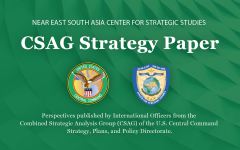China’s Investments in Security Cooperation in the Middle East
October 15, 2022 2022-10-15 14:39China’s Investments in Security Cooperation in the Middle East
China’s Investments in Security Cooperation in the Middle East
CSAG STRATEGY PAPER
By: MAJ Ibrahim ELVEREN, TUR ARMY, Action Officer, CSAG CCJ5
13 October 2022
Overview:
Aiming to change the world order established by the USA, China has taken necessary steps to achieve this, especially since 2010. To understand China’s goals, we only need to look at the Chinese long-term timeline also shared by President Xi Jinping. Accordingly, Beijing aims to become the dominant power in ten leading technologies by 2023, to be the innovation leader in all advanced technologies and complete the modernization of national defense and military by 2035, and to be unambiguously the number one country in the world, pushing to build the country into a fully developed and prosperous nation by 2049. Developments in favor of China may allow the targets to be reached before the determined deadlines.
Although the goal is to be active worldwide, it is necessary to concentrate on certain regions to achieve this gradually. Outside of Asia-Pacific, the Middle East is the most critical region of the world for China.
Connecting China through the Suez Canal to the Mediterranean and Europe, the Middle East is a unique geostrategic location for Beijing, a critical source of much-needed energy resources, and an area of expanding economic ties. In turn, Middle Eastern countries see Beijing as the most important world capital after Washington because of China’s considerable economic power.
The People’s Republic of China (PRC) has recently deepened its economic and diplomatic interaction with the Middle East. China’s role is multi-faceted, encompassing trade and investment, the energy sector, security cooperation, and diplomatic activities.
This document discusses whether Beijing is increasing its influence in the Middle East. It will also analyze China’s plan of action in the Middle East and focuses on China’s security cooperation investments, especially with Saudi Arabia and the United Arab Emirates.
Key Points:
- Beijing aims to become the dominant power in ten leading technologies by 2023, to be the innovation leader in all advanced technologies and complete the modernization of national defense and military by 2035, and to be unambiguously the number one country in the world by 2049.
- China’s role in the Middle East in recent years has been multifaceted, encompassing trade and investment, the energy sector, security cooperation, and diplomatic activities.
- China is willing to use the security cooperation tool to achieve its economic, political, and military goals.
- Difficulties and the restrictive arms sales policies of major exporters like the US, mostly pertaining to items such as armed drones, have pushed countries like Saudi Arabia and the UAE to look for other available alternatives with fewer strings attached.
- To anticipate possible areas of cooperation and competition, it is necessary to understand China’s approach to protecting its interests.
- The preferred position of the US as a military and security partner in the Middle East is still secure.
The US should look for ways to prevent efforts by AOR countries to reduce their reliance on US security by strengthening ties with other security providers, particularly Russia and China.
View other USCENTCOM Combined Strategic Analysis Group (CSAG) papers here.
The opinions and conclusions expressed herein are those of a number of international officers within the Combined Strategic Analysis Group (CSAG) and do not necessarily reflect the views of United States Central Command, not of the nations represented within the CSAG or any other governmental agency.







